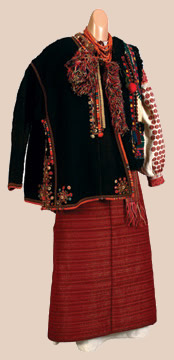Carpathian Echoes: Textile Materials and Technology in the Carpathian Mountains of Romania and Ukraine

Florica Zaharia
Thursday, March 9, 2017
Ukrainian Museum
New York, NY
This beautiful exhibition covers textiles of all kinds–clothing, household, and carpets–from both the Rumanian and Ukrainian sides of the Carpathian mountains. Drawn largely from the collection of Florica Zaharia, the exhibit highlights wools, weaving techniques, and similarities and differences from village to village and area to area. The exhibition is co-curated by Marika Shust, Director of the Ukrainian Museum. The Ukrainian textiles in the exhibition are from the permanent collection of that Museum. The one- hour tour will be led by Florica Zaharia, Emeritus Curator-in-charge of Textile Conservation at the Metropolitan Museum, who is now establishing Rumania’s first textile museum.
In the nineteenth and early twentieth centuries domestic textile materials were produced manually, step by step as dictated by tradition, from the cultivation of plants and the breeding of animals to the final product, although industrialization gradually impacted the established processes in various ways. Consistent geo-climatic conditions throughout the mountain regions allowed for the production of similar materials for textiles, and created comparable needs for the home textile industry in both countries. The changing seasons, especially the hot summers and cold, humid winters, necessitated two types of fabrics: one made of cellulosic fibers that was ideal for summer, and the other made of proteinic fibers for winter. Various qualities of fabric called panza (Romanian) and polotno (Ukrainian) were woven of hemp, as that was the only plant fiber that could successfully be cultivated under the harsh mountain climate. Sheep wool was used for winter costumes and textiles, as well as for the woven felt called panura (Rom.) and sukno (Ukr.) that was essential for winter. The wool was coarse, as sheep lived outdoors year-round.
Home textile production was women’s work, and the most important textiles that women made were textiles for the home and clothing. The physical, aesthetic and symbolic qualities of the materials they produced were derived from each product’s function. Plain weave, twill and tapestry weave, and embroidery were characteristic of traditional home textile production of the Carpathians, as were the associated traditions.
Examples of costumes and textiles produced in the context of the home textile industry in the Carpathians of Romania and of Ukraine are displayed here together for the first time. For scholarly reference, materials reflecting the textile fibers and their technological transformation are also on display.
